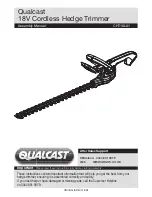
24 ENGLISH
OPERATION
Attaching the shoulder harness
CAUTION:
Always use the shoulder harness
attached to the tool. Before operation, adjust the
shoulder harness according to the user size to
prevent fatigue.
CAUTION:
Before operation, make sure that
the shoulder harness is properly attached to the
hanger on the tool.
CAUTION:
When you use the tool in combi-
nation of the backpack-type power supply such
as portable power pack, do not use the shoulder
harness included in the tool package, but use the
hanging band recommended by Makita.
If you put on the shoulder harness included in the
tool package and the shoulder harness of the back-
pack-type power supply at the same time, removing
the tool or backpack-type power supply is difficult in
case of an emergency, and it may cause an accident
or injury. For the recommended hanging band, ask
Makita Authorized Service Centers.
For DUR369A
1.
Put on the shoulder harness and fasten the
buckle.
►
Fig.29
2.
Clasp the hook on the shoulder harness to tool's
hanger.
►
Fig.30:
1.
Hook
2.
Hanger
3.
Adjust the shoulder harness to a comfortable
working position.
►
Fig.31
The shoulder harness features a means of quick
release.
Simply squeeze the sides of the buckle to release the
shoulder harness.
►
Fig.32:
1.
Buckle
For DUR369L
1.
Wear the shoulder harness on your left shoulder.
►
Fig.33
2.
Clasp the hook on the shoulder harness to tool's
hanger.
►
Fig.34:
1.
Hook
2.
Hanger
3.
Adjust the shoulder harness to a comfortable
working position.
►
Fig.35
The shoulder harness features a means of quick
release.
Pull the strip as illustrated to release the tool from the
shoulder harness.
►
Fig.36:
1.
Strip
Adjusting the hanger position
For DUR369A only
For more comfortable handling of the tool, you can
change the hanger position.
1.
Loosen the hex socket head bolt on the hanger
and slide it to a comfortable working position.
►
Fig.37:
1.
Hanger
2.
Hex socket head bolt
2.
Adjust the hanger position as shown in the figure
and then tighten the hex socket head bolt.
►
Fig.38
1
The hanger position from the ground
2
The cutting tool position from the ground
3
The horizontal distance between the hanger
and the unguarded part of the cutting tool
Correct handling of the tool
WARNING:
Always position the tool on your
right-hand side.
Correct positioning of the tool allows
for maximum control and will reduce the risk of seri-
ous personal injury caused by kickback.
WARNING:
Be extremely careful to maintain
control of the tool at all times. Do not allow the
tool to be deflected toward you or anyone in the
work vicinity.
Failure to keep control of the tool
could result in serious injury to the bystander and the
operator.
WARNING:
To avoid accident, leave more
than 15m (50 ft) distance between operators when
two or more operators work in one area. Also,
arrange a person to observe the distance between
operators. If someone or an animal enters the
working area, immediately stop the operation.
CAUTION:
If the cutting tool accidentally
impacts a rock or hard object during operation,
stop the tool and inspect for any damage. If the
cutting tool is damaged, replace it immediately.
Use of a damaged cutting tool may result in serious
personal injury.
CAUTION:
Remove the blade cover from the
cutter blade when cutting the grass.
Correct positioning and handling allow optimum control
and reduce the risk of injury caused by kickback.
DUR369A
►
Fig.39
DUR369L
►
Fig.40
When using a nylon cutting head (bump & feed
type)
The nylon cutting head is a dual string trimmer head
provided with a bump & feed mechanism.
To feed out the nylon cord, tap the cutting head against
the ground while rotating.
►
Fig.41:
1.
Most effective cutting area
Summary of Contents for 0088381889902
Page 2: ...Fig 1 12 2 Fig 2 12 1 2 3 4 5 8 9 10 11 Fig 3 2 ...
Page 4: ...2 1 Fig 7 1 2 Fig 8 1 2 Fig 9 2 1 Fig 10 2 1 Fig 11 3 2 1 Fig 12 1 3 2 Fig 13 1 3 2 Fig 14 4 ...
Page 8: ...Fig 39 Fig 40 1 Fig 41 8 ...
Page 9: ...3 m 80 mm 100 mm Fig 42 9 ...
Page 10: ...3 m 80 mm 100 mm Fig 43 10 ...
Page 11: ...11 4 5 m 100 mm Fig 44 ...
Page 12: ...12 150 mm 1 mm 0 75 m x 2 Fig 45 Fig 46 1 2 Fig 47 ...
















































